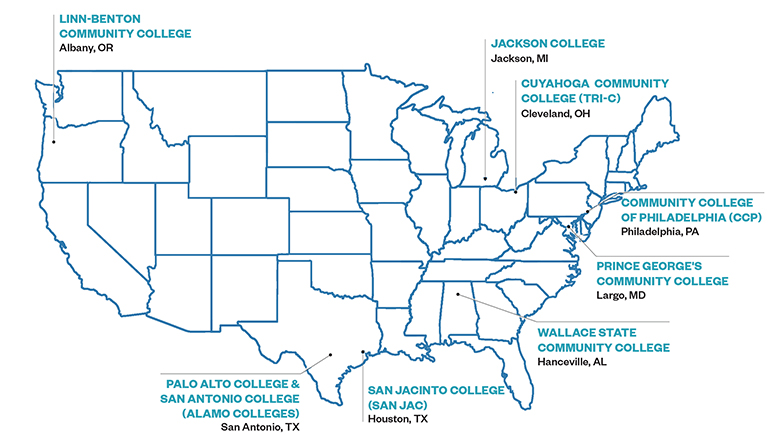Early participants of the guided pathways model to improve student success have taken various approaches to develop and implement their efforts for whole-college redesign, but they do share some common elements, according to a new report.
The Community College Research Center (CCRC) at Columbia University in New York today released the report and five accompanying case studies that examine the efforts of eight community colleges participating in the American Association of Community Colleges’ (AACC) Pathways Project. AACC’s pilot initiative, which launched in 2015, included 30 colleges in the first cohort, including the eight that CCRC studied.
One common thread among the eight colleges is the early and continuous engagement of the entire college community, the report says. Another common thread: pathways is a marathon, not a sprint.
“Implementing guided pathways is not a quick or linear process but one that requires learning and iteration over several years,” the report says.
A change in mindset
All eight community colleges have implemented pathways at scale for at least all entering students, the report says. For example, they all use meta-majors and program maps, have enhanced career and transfer information, and have redesigned their advising.
Hana Lahr, a co-author of the report and a senior research associate at CCRC, says she is impressed with the significant changes the colleges have made so far.
“This has been a big mindset shift at the colleges,” she says, noting that changes in the colleges’ cultures are as tough as the technical aspects of the reforms, but the colleges are making them.
AACC President and CEO Walter Bumphus also emphasizes that systemic change is a tremendous challenge for any college, but strong leaders among the eight colleges have made a difference.
“These college presidents not only took on the challenge, they pioneered the process of utilizing shared governance and continuous process improvement not only to implement changes in processes, but to shift the collective mindset of their college toward transformational change,” he says.
Changes so far
CCRC looked at how the colleges managed their planning and implementing of guided pathways and saw some common strategies, which include:
- Laying the groundwork for whole-college design
- Introducing guided pathways to the college community
- Supporting collaborative planning and implementation
- Sustaining and institutionalizing student success reforms
Before the colleges even began to plan for the reforms, they spent in some cases more than two years examining themselves. This involved their leaders convening faculty, staff and administrators from across the college to look at data on student outcomes, identify barriers to student success and build a commitment to large-scale reform, the report says.
“In every case, this process involved efforts to become better collectors, users and analyzers of student outcomes data,” it says.
Most of the colleges also created more inclusive decision-making structures, which were then used to plan and implement at least one large-scale change before the introduction of guided pathways, the report says.
“These efforts showed that real change is possible if everyone at the college is involved,” it adds.
Getting to know pathways
Introducing guided pathways included college-wide meetings, workshops and other activities to educate the college community about the reform model and included presenting evidence to illustrate how the reforms could benefit students, the report says. It adds that leaders at each of the eight colleges engaged faculty, staff and administration from across the institution and in cross-functional teams to design and implement reforms.
“College leaders supported the teams’ success by encouraging their creativity and experimentation and by providing time and support for them to engage in planning, formative evaluations and professional development related to the reforms,” the report says.
Time to reflect
Colleges that are well into their pathway designs — those in their fourth year and beyond — also have taken time to reflect on their progress to see what’s working and what needs tweaking. That may include reallocating resources, building funding for more academic advisors, technology upgrades and more professional development. Outside of funding to sustain the efforts, the colleges are also recruiting employees who are committed to improving student outcomes.
To date, about 300 colleges are implementing guided pathways as part of formal state or national initiatives, with more doing it on their own, the report says.
The Bill & Melinda Gates Foundation funded the report.

